MaxPreps senior writer grew up in the 'Golden Era' of Hoosier basketball.
With the Indiana high school boys basketball playoffs kicking off on Tuesday, MaxPreps asked senior writer Dave Krider, a member of the Indiana Basketball Hall of Fame, to reflect on his 60 years of covering the legendary hoops scene in the Hoosier State.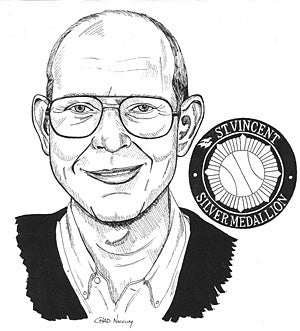
Dave Krider has covered Indiana high school
basketball for 60 years, and was inducted into the
Indiana Basketball Hall of Fame in 2010.
Photo courtesy of Indiana Basketball Hall of Fame
I was born in 1939, the same year that James Naismith, the founder of
basketball, died. In some way, I believe that I was created to carry on
the Eternal Flame for basketball, particularly the Indiana high school
brand. Though I was never on an organized team, I have played thousands
of hours of pick-up.
While growing up, I guess basketball was my
girlfriend because I spent so many hours on neighborhood courts. I put
on a summer all-star game in LaPorte for 31 straight years that drew
great players from as far as 150 miles away. One year I even had three
Mr. Basketball winners.
I am 73 years old and still play Noon Hoops two days a week at the LaPorte YMCA. God truly has blessed my life.
Slideshow: The 10 Largest High School Basketball Gyms in Indiana
The Early Years: Fuzzy Vandivier and John WoodenIndiana's first great high school basketball player was Robert "Fuzzy" Vandivier, who led
Franklin to three consecutive state championships from 1919-22.
Vandivier has long been considered one of Indiana's greatest ball-handlers and I found out why when I interviewed his niece, Ann Turner, for my book "Indiana High School Basketball's 20 Most Dominant Players." The foreword was written with a dead-on analysis and great humor by Gov. Mitch Daniels.
Turner told me that after playing in his first basketball game at age six.
"Uncle Fuzzy said that he ran all the way home because he was so excited," Turner said. "He told grandma that all he wanted for Christmas was a basketball. Unfortunately grandma didn't know anything about basketball, and when Uncle Fuzzy opened his present, he got a FOOTBALL! He learned how to dribble the football and shoot with it."
Vandivier and his teammates eventually moved on to hometown Franklin College where they again had great success and were nicknamed the "Franklin Wonder Five."
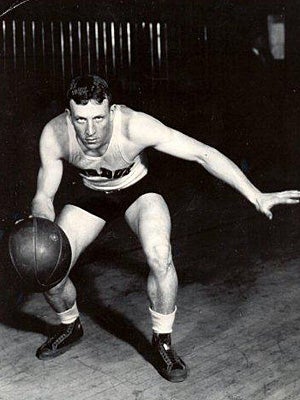
Before becoming a legendary coach, John Wooden
played high school basketball at Martinsville.
Photo courtesy of Indiana Basketball Hall of Fame
Not long afterwards, a youngster named John Wooden — who had idolized Fuzzy Vandivier — leaped onto the Hoosier scene at
Martinsville. A shy, religious teenager, he helped his team win the state title in 1926-27 and finish second twice. He grew up on a farm playing at times with Branch McCracken, who later coached Indiana University to a pair of NCAA titles. His first basketball was a combination of old socks and rags sewed together by his mother.
Wooden once told Indianapolis Star sportswriter Bob Williams, "In those days you couldn't grow up in Indiana and not have a basketball touch you in some way."
Wooden, of course, went on to become an All-American at Purdue University and eventually led UCLA to a record 10 NCAA championships. He was the first ever to make the Naismith Basketball Hall of Fame both as a player and coach.
We served on the McDonald's All-American committee and I was proud to call him a friend. He always took my calls over the years while living in Southern California.
I was blessed to grow up in what I still believe was the Golden Era of Indiana high school basketball.
Click 'Next' to continue reading.{PAGEBREAK}
The Golden Era: Bobby Plump and Oscar RobertsonMy 60-year love affair with Hoosier Hysteria began in 1954 as a 14-year-old freshman in front of our first tiny black-and-white television set. My family sat spell-bound watching tiny
Milan stun mighty
Muncie Central 32-30 on Bobby Plump's last-second, 15-foot jump shot following a long stall. It is still the most famous basketball game in Indiana history.
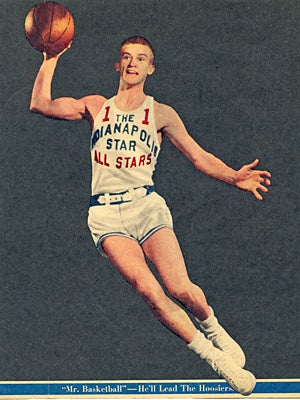
Bobby Plump made arguably the biggest shot in
high school basketball history.
Photo courtesy of Indiana Basketball Hall of Fame
That clutch shot came before a capacity crowd of 15,000 at Butler University and paved the way for Plump to become a success in college and later in business. In 1995, for example, he opened a successful restaurant/sports bar in northeastern Indianapolis aptly named "Plump's Last Shot."
At least one man was known to have died of a heart attack while watching the game on television.
That team long ago was immortalized in the movie "Hoosiers," but Plump told me for my book that the only factual part of the movie was "the last 18 seconds." Indianapolis Star sports writer Bob Collins wrote (maybe not facetiously) that had Plump missed that shot he would have ended up "pumping gas in Pierceville (his tiny hometown)."
Like Vandivier and Wooden before him, Plump had his own unique story about growing up around the game. He and his friends grew a special toughness from playing on a farm where a manure pile lurked very close to the court. Players never called fouls and Plump admitted he landed in that pile many times.
He was quick to add, though, "But they didn't guard you too closely after that."
The next year I entered
Elkhart High School as a sophomore and we opened North Side Gym, a fabulous palace which seated 8,200. It was listed in "Ripley's Believe It Or Not" as the largest high school gym in the world at that time. Our Blue Blazers had made their first Final Four the previous year, losing in the first round to Muncie Central, and were to make another Final Four trip my junior year.
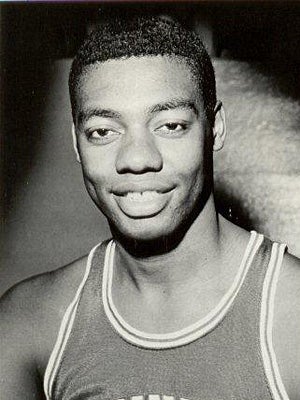
Oscar Robertson starred for Indianapolis Crispus
Attucks.
Photo courtesy of Indiana Basketball Hall of Fame
Though I was just a fan, I quickly grew to love basketball and saw many great games at North Side over the years. Some years we sold 5,500 season tickets.
Milan had beaten a young Indianapolis Crispus Attucks team in the semistate and the next year Attucks emerged as a powerhouse, led by junior Oscar Robertson, whom I still rank as the greatest all-around player in Indiana history. Oscar led Attucks to back-to-back state titles and was named Mr. Basketball in 1956. He was an awesome passer with great moves and once scored a city-record 62 points in a single outing.
I still followed him during his brilliant career at the University of Cincinnati and I believe part of the reason I became a pioneer in covering high school sports nationally was to discover "the next Oscar Robertson." When I grew up there was little or no knowledge about prep athletes outside of our immediate area. You may have heard about some top players in your state, but that knowledge definitely ended at the border.
Click 'Next' to continue reading.{PAGEBREAK}
The Golden Era Continued: Jimmy Rayl, Rick Mount, and George McGinnisOne of my first years at the Elkhart Truth I wrote a column about Lew Alcindor (now Kareem Abdul-Jabbar) from Power Memorial in New York City. I still have his high school picture in my file. In later years as a freelancer I wrote the first national stories about Magic Johnson and Patrick Ewing.
Working for daily newspapers in northern Indiana, I was able to see — either in person or on TV — many of the top basketball players since 1961.
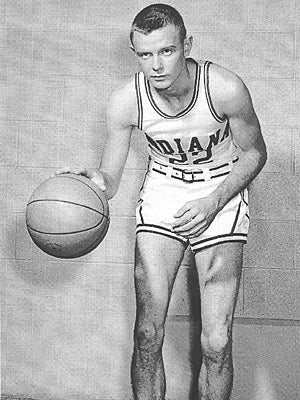
Jimmy Rayl from Kokomo was one of the best
shooters in Indiana history.
Photo courtesy of Indiana Basketball Hall of Fame
But while I was still in college, I fell in love with the game of Jimmy Rayl, the Splendid Splinter from
Kokomo. Jimmy was 6-foot-2 and 145 pounds — soaking wet. He always had the "green light" and often cut loose with shots from close to half court. It seemed like they soared to the rafters and then hit nothing but net. He was the most spectacular player I ever saw. Jimmy was Mr. Basketball and winner of the coveted Trester Award for mental attitude in 1959.
Little did I know that when he came to Indiana University, I would be a junior basketball manager and become a friend. One Saturday morning the two of us went to the gym and shot for an hour or two. It was both embarrassing and a fond memory for me because Jimmy rarely missed anything and I didn't hit much of anything.
He'll always be my favorite player and he cemented our relationship when he and mutual friend Dennis Kasey, a sportscaster from Indianapolis, helped me with a book signing in Indianapolis during the week I was inducted into the Indiana Basketball Hall of Fame. We were laughing and telling stories for several hours and the uproar in a normally quiet Borders book store helped me sell 17 books — considered very good for a walk-on.
Jimmy and
New Castle's Ray Pavy hooked up in probably the state's most famous regular-season game. They combined for an even 100 points, with Pavy netting 51 and Rayl 49. New Castle won the game 92-81. Rayl once made an astounding 532 consecutive free throws while practicing in a church gym.
In his senior year, Jimmy landed on the side of the scorer's bench and hurt his eye during a game against Muncie Central. He received several stitches and a patch that covered his swollen eye so fully he barely could see. All he did when he returned to the game was to drill four or five straight shots and make the decisive free throws in a 79-77 win over the No. 1, previously-unbeaten Bearcats. He finished with 45 points.
The next day Indianapolis News sportswriter Corky Lamm came up with my all-time favorite description when he wrote, "Sickly, spindly Jimmy Rayl caught a Bearcat by the tail; wouldn't let him out alive; shot him dead with 45."
Long-time Purdue University assistant coach Bob King once told me that Rayl "has to be one of the best shooters and probably had the best range of any shooter I ever have seen."
He set many records without benefit of the 3-point basket and held the Big Ten record with a 56-point game before Rick Mount came along with a 61-point explosion for Purdue. Had Jimmy and Rick played in the 3-point era, their records probably would be untouchable today.
Mount, playing for small-town
Lebanon, was Mr. Basketball in 1966. He was the first high school player from a team sport to appear on the cover of Sports Illustrated. He told me that the SI photographer followed him everywhere — almost even into the bathroom — and had to search a long time to find a barn (even though he did not live on a farm) for the background of the cover picture.
You can take your choice — Rayl or Mount — but they are the two best shooters Indiana has ever produced and possibly the two best in the entire nation.
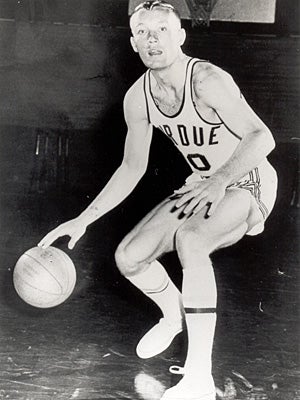
Rick Mount was another top shooter from the
Hoosier State.
Photo courtesy of Indiana Basketball Hall of Fame
Rick "The Rocket" used to shoot 500 shots a day and still did the last time we talked because he runs basketball camps every summer and he reasons — correctly — that he has to retain his ability to demonstrate for younger players.
Mount learned how to shoot by firing tennis balls into a bottomless cashew can nailed to his porch. His fifth grade games drew crowds of close to 1,000 and some fans came from as far away as 100 miles to watch this rising young phenom.
One night in high school he picked up his date and headed for a movie. However, he spotted some out-of-town players in a pick-up game at a local park and his passion for competition took over.
He told his date, "You won't believe what I'm going to do, but I'm going to take you home." In his own way, the story did have a happy ending: "She slammed the door on me (at her house) and I never had another date with her," he said. "I went back and played for two hours."
The Fourth of July Carnival in Lebanon is one of my favorite stories. Mount started shooting free throws at two shots for $1. The reward was a teddy bear. Noting his success, fathers began feeding him money and he reciprocated by winning teddy bears for their daughters. He finally cleaned the carnival operator out (28 teddy bears in 45 minutes) and looking down the midway all he could see was little girls carrying teddy bears under their arms.
The carnival worker was so impressed that he asked Mount to go on the road with him and "win a lot of money."
Years later Mount was running a girls basketball camp and a mother told him that she had received one of his teddy bears as a youngster.
In 1969 George McGinnis, a powerful forward from
Indianapolis Washington, held center stage as Mr. Basketball. McGinnis was also an All-American football player and is probably the best two-sport athlete ever produced in the Hoosier state.
He and Steve Downing formed a formidable inside threat and paced Washington to a state championship during a year in which teams entering the Final Four had combined for just one defeat. Growing up, McGinnis and his buddies had spent many summer nights in the quiet, empty parking lot at Butler Fieldhouse sitting in their car and taking turns "broadcasting" their future state-title game.
Hoosier Basketball Magazine publisher Garry Donna told me that he once saw McGinnis cut so hard that his tennis shoe literally exploded. He called him "the most skilled power player I've ever seen."
Click 'Next' to continue reading.{PAGEBREAK}
The Modern Era: Scott Skiles, Steve Alford and Damon BaileyI'm jumping to 1982 to talk about
Plymouth guard Scott Skiles because I regard him as one of the toughest, most competitive kids I've ever had the privilege to watch. One summer day I even brought three friends with me to Plymouth and we played pick-up games with Skiles and his teammates for a couple hours.

Scott Skiles led Plymouth to a state title in 1982.
Getty Images
After watching him lead Plymouth, a town of 10,000 with no starter over 6-2, to the state title in 1982, I dubbed him "Indiana's Greatest Overachiever." I'll never forget the clutch 22-foot shot he made at the buzzer to send the title game against
Gary Roosevelt into the first of two overtimes.
I also vividly recall the night he came to LaPorte suffering from mononucleosis and carrying a 103-degree temperature. I don't know why he was even at the game and I knew the host team was going to let him shoot, figuring there was no way he would be effective. All he did was set a gym record with 37 points.
Michigan State was the only major college to offer Skiles a scholarship, but he continued to disprove critics by making All-America and having a fine NBA career as a player and coach.
Michigan State coach Jud Heathcote told me that Skiles "had great confidence and wouldn't back down to anybody. He always thought that he was a little better than he was, and went out and proved it. I only coached two guys who could will a team to win — Magic (Johnson) and Scott Skiles."
Steve Alford, who played for his father, Sam, at New Castle, used the gymnasium as a classroom. He was a regular on his dad's bench at age three, learning to add by watching the scoreboard numbers change as the game progressed and how to read and spell by looking at game programs and names on the backs of uniforms.
He was a relentless trainer and told me with a touch of pride, "I never let the snow stay on our driveway." As a youngster he would squeeze tennis balls in his hands at night. The Alfords knew he had gone to sleep when they heard the tennis balls fall to the floor.
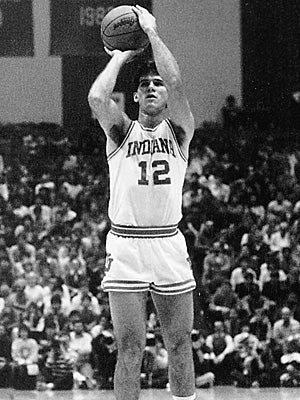
After starring at New Castle, Steve Alford went on to
play for Indiana University.
Getty Images
In 1983 Alford fulfilled a prophecy by being named Mr. Basketball. Just after his second birthday, his parents had posed him with a basketball on their annual Christmas card proudly proclaiming that he some day would be Mr. Basketball. Of course, he later led Indiana University to an NCAA title, won an Olympic gold medal and today is a very successful coach at the University of New Mexico.
In Alford's senior year, 1983,
Anderson and
Marion staged the greatest individual duel in Final Four history during the state semifinals. James Blackmon exploded for 52 points, but his Marion team was nipped by Anderson 89-87 in a double-overtime thriller as Troy Lewis countered with 42.
Franklin's 65-year-old record of three consecutive state championships was finally matched when the Marion Giants notched their third title in a row in the 1986-87 campaign. Sharpshooters Jay Edwards and Lyndon Jones were deservedly rewarded with co-Mr. Basketball honors.
The coach of that team, Bill Green, had won a pair of titles earlier at Marion before taking another job. Counting one at Indianapolis Washington, the wily redhead is Indiana's coaching king with six state championships. He perfected the match-up zone and often taught it to college coaches.
In 1990 a kid named Damon was named Mr. Basketball. Damon Bailey and Oscar Robertson are probably the only two Hoosier stars totally recognized by their first names. No second name ever needed.
Bailey first hit the headlines as an eighth grader through the recruiting of Indiana University's legendary coach, Bob Knight. He started for four years at
Bedford North Lawrence and carried a team with no other Division I players to the state title in 1990. That title game drew a national-record crowd of 41,046. The was the last season in an incredible string of 61 consecutive years that Indiana's state finals were sold out.
He also became Indiana's career scoring leader with 3,134 points and was named National Player of the Year by USA Today.
For many years, Indiana's one-class basketball tourney was the envy of the nation. It was always the hottest ticket in town. However, the axe fell in 1997-98 when Indiana split into a four-class tournament for basketball and the interest started to evaporate.
Even though I fully understand what it has done for the smaller schools, I have heard coaches from many of those schools say they still wish they could take on the big boys. I've always wished that Indiana would have gone the Kentucky route: have a small-school tourney during the regular season, then everyone still plays at the end of the season in a single-class tourney.
Click 'Next' to continue reading.{PAGEBREAK}
The Class-System Era: Greg Oden, Mike Conley and the Zeller BrothersI will note two highlights from the class-system era.
No. 1, was
Indianapolis Lawrence North, which became the third team in history to capture three consecutive state titles from 2003-06. Coach Jack Keefer's Wildcats could have beaten anybody, but they did play in the biggest class, 4A.

Greg Oden was arguably the best big man in
Indiana history at Lawrence North.
Getty Images
I was inspired to follow the Wildcats for all three years with the belief that they would win those three titles in a row. I told Keefer what I thought was going to happen and he gave me assistant coach J.R. Shelt to be co-author for my eventual book, "Uncaged." I never had more fun than watching superstars Greg Oden and Mike Conley make history.
As juniors, they played the greatest high school game I've ever seen when they shut down Indianapolis Arlington 60-45 in the sectional semifinals. Arlington — boasting the quickest starting five I've ever seen — had beaten the Wildcats earlier in the year by 10 points, were unbeaten and ranked No. 3 in the nation. Hundreds of people were turned away from the 3,000-seat gym.
Arlington drove at the 7-foot Oden on practically every play and all he did was block 18 shots without getting into foul trouble. Meanwhile point guard Conley, who played sparingly in the loss to Arlington due to a toe injury, handled tremendous defensive pressure like a pro and rarely turned the ball over.
Conley and Oden went unbeaten as seniors and the Wildcats were named unanimous national champions. They also tied the state record of 45 consecutive victories, which was broken following their graduation. Oden was named Mr. Basketball in 2006 and was named Gatorade National Basketball Player of the Year for the second time. He and Conley both made the McDonald's All American team.
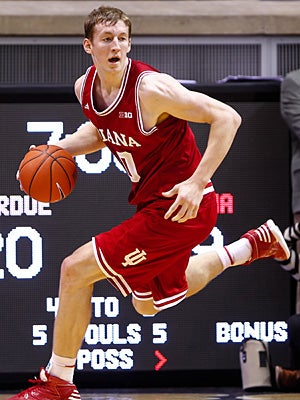
Cody Zeller is the latest member of his family to
dominate the Indiana hoops scene.
Getty Images
I consider Greg Oden the best big man and defender Indiana ever has produced, while I rank Conley as our state's premier point guard. Conley was a great passer, ball handler and defender and could score whenever it was needed.
They went on to lead Ohio State University to NCAA tournament runner-up honors as freshmen before entering the NBA draft. Conley is currently starring for the Memphis Grizzlies. Oden was the No. 1 draft pick, but has been injury-plagued during his career. He still is young, however, and should he recover from his latest surgery he can still have a good professional career.
The Zeller family of
Washington provided my second class-system highlight. Luke, Tyler and Cody were multi-talented 7-footers who combined to win four Class 3A state titles. Each was also named Mr. Basketball.
Luke started it all when he made a fantastic buzzer-beating half-court shot to stun Plymouth 74-72 in overtime for the 2004-05 championship. He played at Notre Dame and now is in the NBA, as is Tyler following a fine career at North Carolina.
The youngest, Cody, is making a big name for himself at No. 1-ranked Indiana University. After his sophomore year, it's going to be hard to keep him out of the NBA draft because he is a big guy who runs like a deer.
* * *
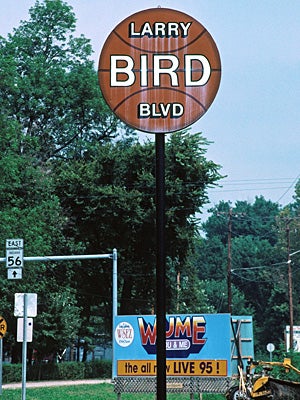
Larry Bird is a legend in his hometown of French
Lick.
Getty Images
I also need to mention Larry Bird. He did not make my top 20 because he didn't match the qualifications of being Mr. Basketball or winning a state championship at
Springs Valley (French Lick).
Bird averaged 30.6 points and 20.6 rebounds as a senior, but at 6-7 he pretty much towered over his competition. In one game he amassed 55 points and 38 rebounds, both school records.
However, coach Jim Jones told me, "We were just fortunate to get him on the Indiana All-Star team."
Following a very brief stay at Indiana University, he grew two inches and put on some muscle by working on a garbage truck in French Lick for a year before being coaxed to attend Indiana State University in Terre Haute.
The rest is history, as he led the Sycamores to NCAA runner-up honors and put together a Hall of Fame career in the NBA. He was voted to the NBA's 50th Anniversary All-Time team and is the only person in NBA history to be named Most Valuable Player, Coach of the Year and Executive of the Year.